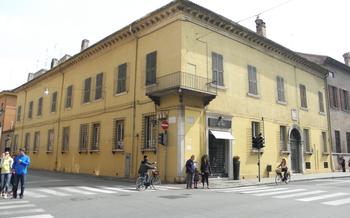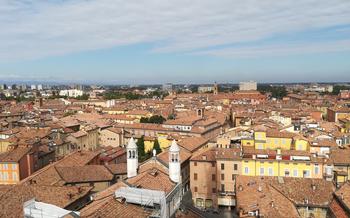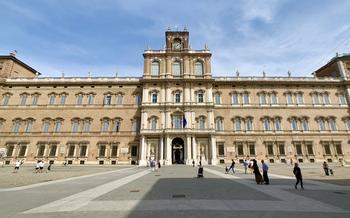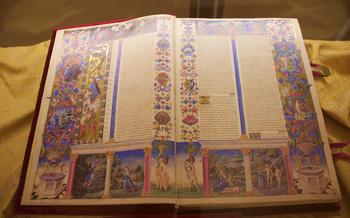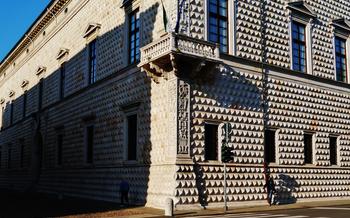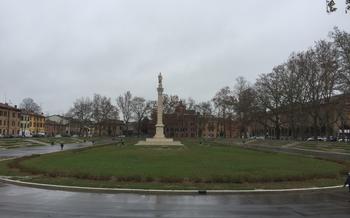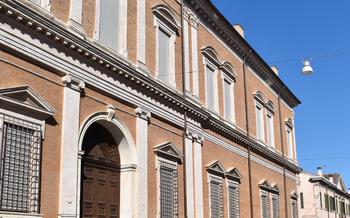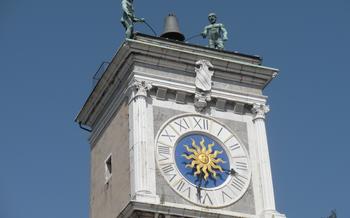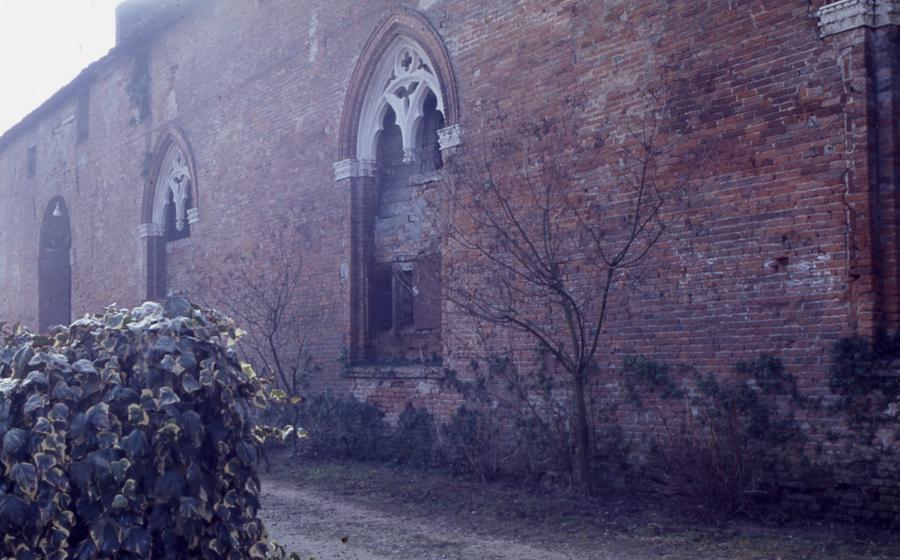
Delizia di Voghiera (Voghiera Villa)
- Delizia di Voghiera: A Historical Gem in the Heart of Emilia-Romagna
- The History of the Villa
- The Architecture of the Villa
- The Gardens of the Villa
- The Art of the Villa
- The Villa Today
- How to Get to the Villa
- When to Visit the Villa
- What to See and Do at the Villa
- Where to Eat Near the Villa
- Where to Stay Near the Villa
- Things to Do Near the Villa
- Tips for Visiting the Villa
- Interesting Facts About the Villa
- Insider Tip
Delizia di Voghiera: A Historical Gem in the Heart of Emilia-Romagna
The Delizia di Voghiera, a majestic villa nestled in the picturesque countryside of Voghiera, Italy, stands as a testament to the architectural prowess and cultural heritage of the region. Built in the 16th century by the illustrious Este family, this enchanting retreat was designed as a sanctuary for relaxation, indulgence, and lavish entertainment.
The Delizia di Voghiera encapsulates the essence of the Renaissance era, boasting an exquisite fusion of architectural styles and artistic influences that has earned it the title of a UNESCO World Heritage Site. Embark on an unforgettable journey as we delve into the rich history, stunning architecture, captivating gardens, and artistic treasures that make this villa a true masterpiece.
The History of the Villa
The Delizia di Voghiera was commissioned in 1491 by Ercole I d'Este, Duke of Ferrara, Modena and Reggio, as a hunting lodge and a place to retreat from the city. The villa was designed by the architect Biagio Rossetti, who was also responsible for the design of the city of Ferrara. The construction of the villa was completed in 149
Over the centuries, the villa has been used for a variety of purposes. It was a hunting lodge, a summer residence for the dukes of Este, a military hospital, a prison, and a school. In 1999, the villa was purchased by the municipality of Voghiera, which restored it and opened it to the public in 200
The Delizia di Voghiera is a unique example of Renaissance architecture. It is one of the few surviving examples of a hunting lodge built by the Este family. The villa is also a testament to the skill of Biagio Rossetti, one of the most important architects of the Renaissance period.
The Architecture of the Villa
The Delizia di Voghiera is a masterpiece of Renaissance architecture, designed by the renowned architect Biagio Rossetti. The villa's exterior is characterized by its symmetrical facade, adorned with elegant pilasters, intricate friezes, and graceful arched windows. The villa's interior is equally impressive, featuring a grand entrance hall, a series of spacious rooms, and a stunning ballroom. The different styles of architecture represented in the villa reflect the changing tastes and influences of the various periods in which it was built. The villa's main features include its graceful loggia, which offers stunning views of the surrounding countryside, and its impressive staircase, which is decorated with intricate carvings and frescoes.
The Gardens of the Villa
The gardens of the Delizia di Voghiera are a true masterpiece of landscape architecture. Designed in the 16th century by Pirro Ligorio, one of the most renowned architects of the Renaissance, they are a harmonious blend of Italian and French styles. The gardens are divided into several sections, each with its own unique features.
The Italian garden, located in front of the villa, is characterized by its geometric layout, with straight paths, hedges, and flower beds. The French garden, on the other hand, is located on the sides of the villa and is characterized by its more naturalistic style, with winding paths, groves of trees, and ponds.
The gardens are home to a wide variety of plants and flowers, including roses, lilies, irises, and tulips. There are also several sculptures and fountains scattered throughout the gardens, adding to their beauty and charm. The most notable sculpture is a bronze statue of Hercules fighting the Hydra, which is located in the center of the French garden.
In addition to their aesthetic value, the gardens of the Delizia di Voghiera also have a practical function. They were originally designed to provide food and herbs for the villa's inhabitants. Today, they are used for growing vegetables, fruits, and flowers, which are sold at the villa's farm shop.
The gardens of the Delizia di Voghiera are a beautiful and relaxing place to visit. They are open to the public from April to October, and admission is free.
The Art of the Villa
The Delizia di Voghiera is home to a remarkable collection of art, including paintings, frescoes, sculptures, tapestries, and furniture. The paintings and frescoes are particularly noteworthy, as they were commissioned by the Este family and depict scenes from their lives and history. The villa's art collection is a testament to the Este family's love of beauty and their patronage of the arts.
The paintings in the villa are mostly by Ferrarese artists of the 16th and 17th centuries. Among the most famous painters represented are Dosso Dossi, Garofalo, and Bastianino. Their works depict a variety of subjects, including religious scenes, mythological tales, and portraits of the Este family.
The frescoes in the villa are also by Ferrarese artists, and they decorate the walls and ceilings of many of the rooms. The most famous frescoes are in the Sala del Giudizio, which is decorated with scenes from the Last Judgment. Other frescoes depict mythological scenes, such as the story of Hercules and the Hydra.
In addition to the paintings and frescoes, the villa also has a collection of sculptures and tapestries. The sculptures are mostly by Ferrarese artists of the 16th and 17th centuries, and they include works in marble, bronze, and wood. The tapestries are mostly from the 16th century, and they depict scenes from the Bible and from classical mythology.
The furniture in the villa is mostly from the 16th and 17th centuries, and it is made of a variety of woods, including walnut, oak, and cherry. The furniture is decorated with carvings, inlay, and gilding, and it is a testament to the craftsmanship of the Ferrarese artisans of the time.
The Villa Today
The Delizia di Voghiera, after undergoing extensive restoration work, has been returned to its former glory and is open to the public as a museum and event space. The villa's grand halls and opulent furnishings offer a glimpse into the lavish lifestyle of the Este family. Visitors can wander through the villa's many rooms, admiring the intricate frescoes, sculptures, and tapestries that adorn its walls. The villa's gardens, once overgrown and neglected, have also been meticulously restored and replanted, creating a beautiful and serene oasis for visitors to enjoy.
In addition to its role as a museum, the Delizia di Voghiera is also a popular venue for weddings, conferences, and other events. The villa's unique and historic setting provides a memorable backdrop for any occasion. The villa is also home to a restaurant that serves traditional Italian cuisine, allowing visitors to experience the flavors of the region while enjoying the villa's beautiful surroundings.
How to Get to the Villa
The Delizia di Voghiera is located in the town of Voghiera, about 40 kilometers northeast of Bologna. The villa is easily accessible by car, train, or bus.
By car: Take the A13 motorway and exit at Ferrara Nord. Follow the signs to Voghiera and the Delizia di Voghiera. The villa is located on the outskirts of town, just off the main road.
By train: Take a train to Ferrara station and then take a bus or taxi to Voghiera. The journey takes about 30 minutes.
By bus: Take a bus from Ferrara to Voghiera. The journey takes about 45 minutes.
The closest airports to the villa are Bologna Guglielmo Marconi Airport and Verona Villafranca Airport. From either airport, you can take a train or bus to Ferrara and then connect to Voghiera.
The cost of transportation to the villa varies depending on the mode of transport and the distance traveled. However, you can expect to pay around €10-€20 for a train or bus ticket and €20-€30 for a taxi ride from Ferrara to Voghiera.
When to Visit the Villa
The best time to visit the Delizia di Voghiera is during the shoulder seasons, in spring and fall, when the weather is mild and pleasant. During these months, you can enjoy the villa's gardens in bloom without the crowds of summer. The villa is also open during the winter, but some areas may be closed or have limited hours.
The villa's hours of operation are from 9am to 6pm, every day of the week. The cost of admission is €10 for adults, €8 for students, and €5 for children. There are also guided tours of the villa available, which cost €15 per person.
It is recommended to book your tickets in advance, especially if you are visiting during the peak season. You can book tickets online or by calling the villa's information line.
What to See and Do at the Villa
The Delizia di Voghiera offers a variety of exhibits and activities that are sure to appeal to visitors of all ages. The villa's museum houses a collection of paintings, sculptures, and furniture from the Renaissance and Baroque periods. Visitors can also learn about the history of the villa and its connection to the Este family.
Guided tours of the villa are available in English and Italian. Tours provide visitors with an in-depth look at the villa's architecture, art, and history. The villa also hosts a variety of special events, such as concerts, exhibitions, and lectures. These events provide visitors with the opportunity to experience the villa in a new way.
In the summer months, the villa's gardens are open to the public. Visitors can stroll through the gardens, admire the flowers and sculptures, and relax by the fountain. The gardens are also a popular spot for weddings and other special events.
Where to Eat Near the Villa
There are several excellent restaurants in the vicinity of the Delizia di Voghiera, offering a variety of culinary experiences to satisfy every palate. For a traditional Italian meal, try Trattoria al Cacciatore, renowned for its homemade pasta and regional specialties. Il Giardino, set amidst a beautiful garden, offers a more upscale dining experience with a focus on seasonal ingredients and creative dishes. For a quick and casual bite, head to Panificio Voghiera, a local bakery that serves delicious sandwiches, pastries, and coffee.
No matter what your budget or preferences, you're sure to find a satisfying meal near the Delizia di Voghiera.
Where to Stay Near the Villa
There are several comfortable hotels and accommodations close to the Delizia di Voghiera, catering to different budgets and preferences. For a truly immersive experience, consider staying in a charming historical residence within the villa's grounds. These restored accommodations offer a unique opportunity to step back in time and savor the villa's ambiance fully.
Alternatively, numerous modern hotels in the vicinity provide convenient access to the villa and the surrounding area. These hotels often feature contemporary amenities, such as swimming pools, fitness centers, and conference facilities, making them ideal for business travelers or those seeking a more luxurious stay.
Whether you prefer the allure of history or the comforts of modernity, you'll find suitable accommodations near the Delizia di Voghiera. Prices range from budget-friendly options to exclusive luxury experiences, ensuring that every traveler can find a place to rest and rejuvenate during their visit to this captivating villa.
Things to Do Near the Villa
The Delizia di Voghiera is surrounded by a wealth of other attractions, making it an ideal base for exploring the region. Within a short drive, you can find yourself in the historic city of Ferrara, with its well-preserved medieval center and Renaissance architecture. Other nearby attractions include the Po Delta Park, a UNESCO World Heritage Site known for its natural beauty and biodiversity, and the seaside resort of Comacchio, with its picturesque canals and colorful fishermen's houses.
For those interested in history, the area is home to several castles and fortifications, including the Castello Estense in Ferrara and the Fortezza di San Michele in Comacchio. Art enthusiasts can visit the Pinacoteca Nazionale di Ferrara, which houses a collection of paintings from the 13th to the 18th centuries, or the Museo Archeologico Nazionale di Ferrara, which displays artifacts from the region's ancient past.
Outdoor enthusiasts will find plenty to enjoy in the area as well. The Po Delta Park offers a variety of hiking and biking trails, as well as opportunities for birdwatching and fishing. The beaches of Comacchio are perfect for swimming, sunbathing, and water sports. And for a truly unique experience, you can take a boat trip through the Po Delta, where you can see the traditional fishing villages and the abundant wildlife that calls the area home.
Tips for Visiting the Villa
-
What to wear and bring: The villa is a historical site, so it is important to dress respectfully. Comfortable shoes are also recommended, as there is a lot of walking involved in exploring the villa and its grounds. Be sure to bring a camera to capture the beautiful scenery and architecture.
-
How to avoid crowds: The villa is most crowded during the summer months, so it is best to visit during the shoulder seasons (spring and fall) or on a weekday. If you do visit during the summer, try to arrive early in the morning or late in the afternoon, when the crowds are typically smaller.
-
The best time of day to visit: The villa is open from 9:00am to 6:00pm every day except Monday. The best time to visit is in the morning, when the light is best for photography and the gardens are at their most vibrant.
Interesting Facts About the Villa
The Delizia di Voghiera has a rich and fascinating history, and it is home to a number of interesting facts. For example, the villa was once owned by the Este family, one of the most powerful families in Renaissance Italy. The Este family used the villa as a hunting lodge, and they often hosted lavish parties and events there.
During World War II, the villa was used by the Italian Resistance as a hideout. The Resistance fighters used the villa to store weapons and supplies, and they also used it as a meeting place. The villa was damaged during the war, but it was eventually restored to its former glory.
Today, the Delizia di Voghiera is a popular tourist attraction. Visitors can tour the villa, admire its beautiful gardens, and learn about its history. The villa is also a popular venue for weddings and other events.
Insider Tip
If you're looking for a truly unique experience, be sure to visit the Delizia di Voghiera at night. The villa is beautifully illuminated, and the gardens take on a whole new life in the moonlight. You can wander the grounds, admiring the sculptures and fountains, and soak up the magical atmosphere. It's a truly unforgettable experience.
Another insider tip is to visit the villa during one of its many special events. Throughout the year, the villa hosts a variety of events, including concerts, art exhibitions, and food festivals. These events are a great way to experience the villa in a different light and learn more about its history and culture.

